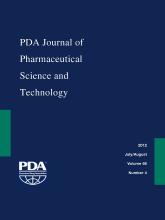Abstract
The control of microbial load on surfaces of research and animal labs as well as of hospital and production rooms is an everyday challenge. Surface sanitization or disinfection of production equipments and rooms by wiping with chemicals is a time-consuming procedure. Its validation is very intricate. Alternatively, fumigation allows overcoming many critical aspects of wiping in both procedure and validation. Moreover, the use of nebulized hydrogen peroxide (H2O2) of moderate concentration resolves remaining reservations as to toxicity, corrosion, and persistence. This paper presents major criteria for the effective use of fumigation with emphasis on a new H2O2 procedure. Focus is set to the proper and simplified validation of the process using standardized biological indicators with defined concentrations of the test organism Geobacillus stearothermophilus. Extensive test results from design of experiment studies support the knowledge of the sanitization process and allows for choosing critical process parameters within well known boundaries. Target values of total kill of 104 to 106 cfu per carrier are reproducibly reached. The new concept has then been applied to the decontamination of small rooms as well as to large multi-rooms up to 750 m3. These case studies are described and illustrate the wide field of application of the technique proposed. The concept presented for validation of the sanitization procedure overcomes the problems associated with conventional surface disinfection validation. It allows for considerable more safety at greatly reduced cost and work.
LAY ABSTRACT: Microbial load on surfaces of research and animal labs as well as of hospital and production rooms has to be maintained low to support aseptic conditions. Surface sanitization or disinfection by wiping with chemicals is time-consuming and its validation intricate. Fumigation as alternative overcomes many critical aspects of wiping in both procedure and validation. Nebulized hydrogen peroxide (H2O2) of moderate concentration has particular advantages in respect to toxicity, corrosion, and persistence. This paper presents major criteria for the effective use of fumigation with emphasis on a new H2O2 procedure. Focus is set to the proper and simplified validation of the process using standardized biological indicators. Test results from design of experiment studies support the knowledge of the sanitization process and allow choosing optimal process parameters. A total kill of 104 to 106 cfu per carrier is reproducibly reached. The new concept has then been applied to decontamination of rooms up to 750 m3. These case studies and benefits are described and illustrate the wide field of application of the technique proposed. The concept presented simplifies validation of the sanitization procedure and allows for considerable more safety at greatly reduced cost and work.
- © PDA, Inc. 2012
PDA members receive access to all articles published in the current year and previous volume year. Institutional subscribers received access to all content. Log in below to receive access to this article if you are either of these.
If you are neither or you are a PDA member trying to access an article outside of your membership license, then you must purchase access to this article (below). If you do not have a username or password for JPST, you will be required to create an account prior to purchasing.
Full issue PDFs are for PDA members only.
Note to pda.org users
The PDA and PDA bookstore websites (www.pda.org and www.pda.org/bookstore) are separate websites from the PDA JPST website. When you first join PDA, your initial UserID and Password are sent to HighWirePress to create your PDA JPST account. Subsequent UserrID and Password changes required at the PDA websites will not pass on to PDA JPST and vice versa. If you forget your PDA JPST UserID and/or Password, you can request help to retrieve UserID and reset Password below.






